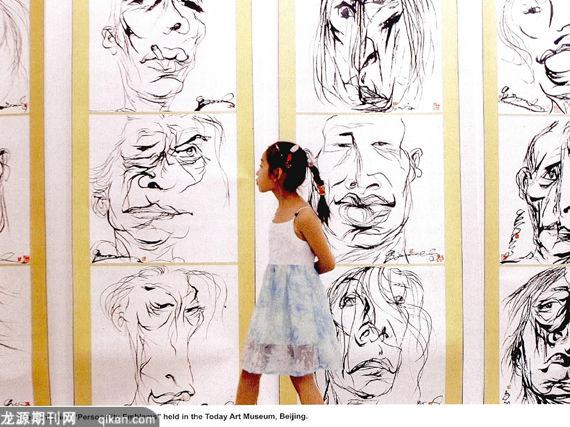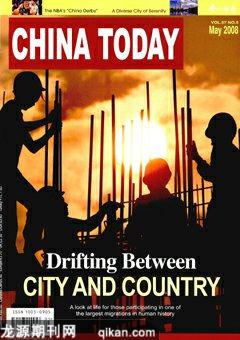Speaking in Black and White
staff reporter ZHANG XUEYING
QI Peng is trying to create a series of pictures on the theme of the Beijing Olympic Games in traditional Chinese ink and wash. However, even she herself is not sure if it is an appropriate way to fully capture the athletes sportsmanship. “Perhaps I should try other means…oil painting, or multiple materials…” Qi Peng thinks aloud.
Traditional Chinese ink and wash has a 1,300-year history. Using a paintbrush, ink and xuan paper (a high-quality rice paper especially suited to traditional Chinese painting and calligraphy), this black-and-white art form has always been considered the embodiment of ancient scholars philosophical thinking and refined taste. Nonetheless,contemporary artists have also begun to look for a new form of this traditional art which can convey both a modern spirit and their individual personalities.

Although Qi Peng is not an avant-garde artist, she pays close attention to painting various themes in her own unique way. She was born in a mountainous region and began learning to paint at 16, developing into a talented artist, especially of landscapes. In her twenties, she received several awards for her impressive works, including the acclaimed Golden Bridge and Pearl of the Village.
In 1984, she gave up a well-paid job to study in the Chinese Painting Department of the China Central Academy of Fine Arts. One of her teachers in the academy recognized her as a gifted student, whose reproductions of master Li Keran are in facsimile.
Li Keran, the leading scholar of Chinese ink and wash at the time, once described Qi Pengs series of pictures of Taihang Mountains as being “wild and free, not like a girls work,” and he took a keen interest in Qi Pengs distinctive style. Later, Qi Peng was influenced by Li Keran and other reputed painters, like He Haixia, Jia Youfu, Zhang Ping, Wang Yong and Huang Runhua, and her works became even more extraordinary and expressive.
In 1992, her work Color · Melody · Movement won the Maple Leaf Award in Canada, and her solo art shows were successively held in the National Art Museum of China and the Museum of the Chinese Revolution in 1993. One year later, Qi was invited to hold an exhibition in New York and was awarded the Oriental Art Innovation Prize. In 1995, she attended the International Art Fair with a series of works entitled Taihang Mountains Scenery and Bright Childhood.
As her fame grew, however, Qi Peng suddenly disappeared from the scene. Eleven years later, she returned to painting with an MBA degree and a doctorate in philosophy. “I used to pursue aestheticism and painting skills, but now I put more emphasis on spiritual connotation,” Qi Peng explains. Apart from painting, she is also doing research on social psychology in a postdoctoral program at Renmin University of China.

In 2006, Qi held an exhibition entitled “Personality Emblems” in the Today Art Museum in Beijing. Mixing Western structuralism with traditional Chinese ink and wash, Qi Peng depicted Chinese personalities through 121 different expressions, using a unique painting language involving chiaroscuro, shadows and lines. The figures show all kinds of people in the modern world. In Worrier, for example, the characters face looks contorted by deep lines, suggesting his extreme anxiety. As for the figure Mope, Qi draws out a dusky expression in the girls eye beneath her curly and tousled hair, expressing her feminine tenderness.
In the 1,300-year-old history of ink and wash, few of the countless figure paintings have managed to address human nature or psychological depth. Therefore, “Personality Emblems” has come to be regarded as filling a historical gap.
According to Qi, her concentration on personality came from her 11-year study of the humanities and the Chinese spirit. Nowadays, she is not simply an artist, but has become a scholar of sociology and psychology. Her dissertations have won a national first prize. Attending the World Conference of Sociology and the International Congress of Psychology helped Qi to think over the living conditions and social problems in China. Through surveys and analysis, she has found that psychological pressure has grown increasingly serious in modern cities. Changes in peoples minds are always reflected in their faces, she believes, which stimulated Qi to paint peoples inner worlds in ink and wash.
In 2007, Qi Pengs art show “Personality Emblems and Chinese Ancient Villages” was exhibited in the Art Museum of Hebei Province, the Museum of Shanxi Province, the International Exhibition Center of Heilongjiang Province and the Shandong Expo. While doing her postdoctoral research, Qi Peng investigated places of cultural interest in Beijing, as well as 50 ancient villages around China. Knowing their history, structure and current situation, Qi concluded that man is conditioned by the natural environment he lives in. That idea is vividly reflected in the series Chinese Ancient Villages. At the same time, the combination of reality and her vivid imagination makes the works fascinating. The well-known artist Jia Youfu appraised Qis style as “special and exciting, observing and expressing the world from a unique point of view.” These works also received awards from the UN World Peace Foundation and the United World Chinese Association.
At the moment, Qi Peng is preparing for a solo art show in August, which includes a third theme. Over the past two years, the series Places of Cultural Interest has taken shape. These 100 newly created pictures not only describe classical constructions, such as the Forbidden City and the Temple of Heaven, but also contain modern and post-modern buildings like the National Museum, the Birds Nest (National Stadium) and the Water Cube (National Aquatic Center).
The series has attracted a great deal of attention from numerous critics. One art critic, Deng Pingxiang, believes that Places of Cultural Interest expresses two significant ideas. On the one hand, it shows an internal tension between modernity and tradition; on the other, the refinement of painting paraphernalia has created a brand-new art language. Instead of simply painting with a paintbrush, Qi also makes use of a broad brush and other oil painting techniques. “It conveys the modern buildings beauty and implicit charm that could not be fully expressed by traditional Chinese painting styles,” Deng says.
Since Places of Cultural Interest puts an emphasis on both spatial structure and humanistic connotation, Shui Zhongtian, a noted fine arts critic, rates Qi Peng as a “significant and irreplaceable modern female painter.”

